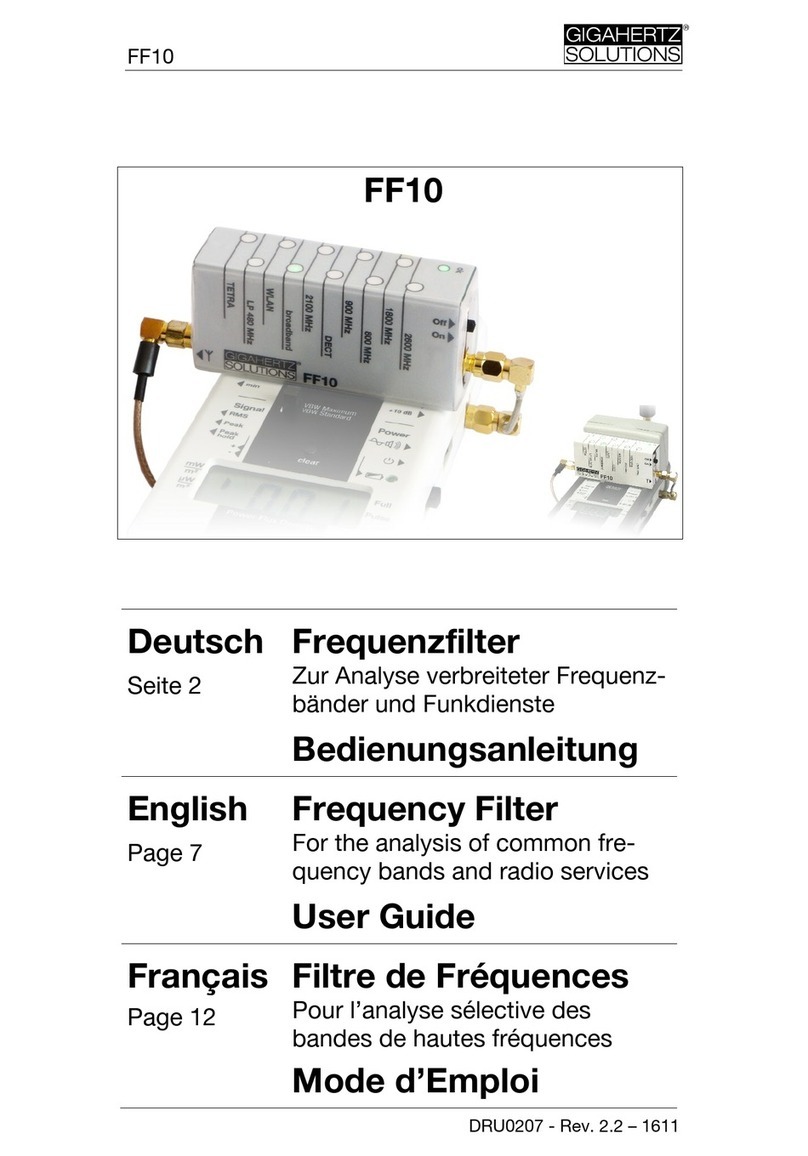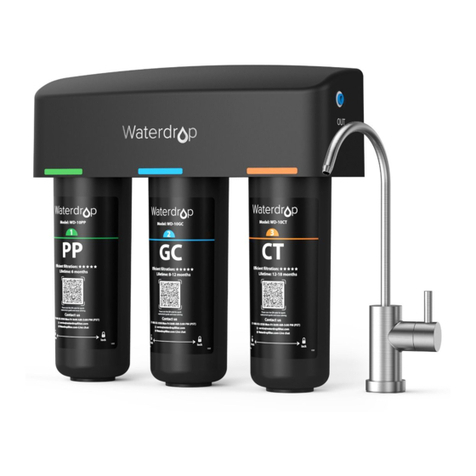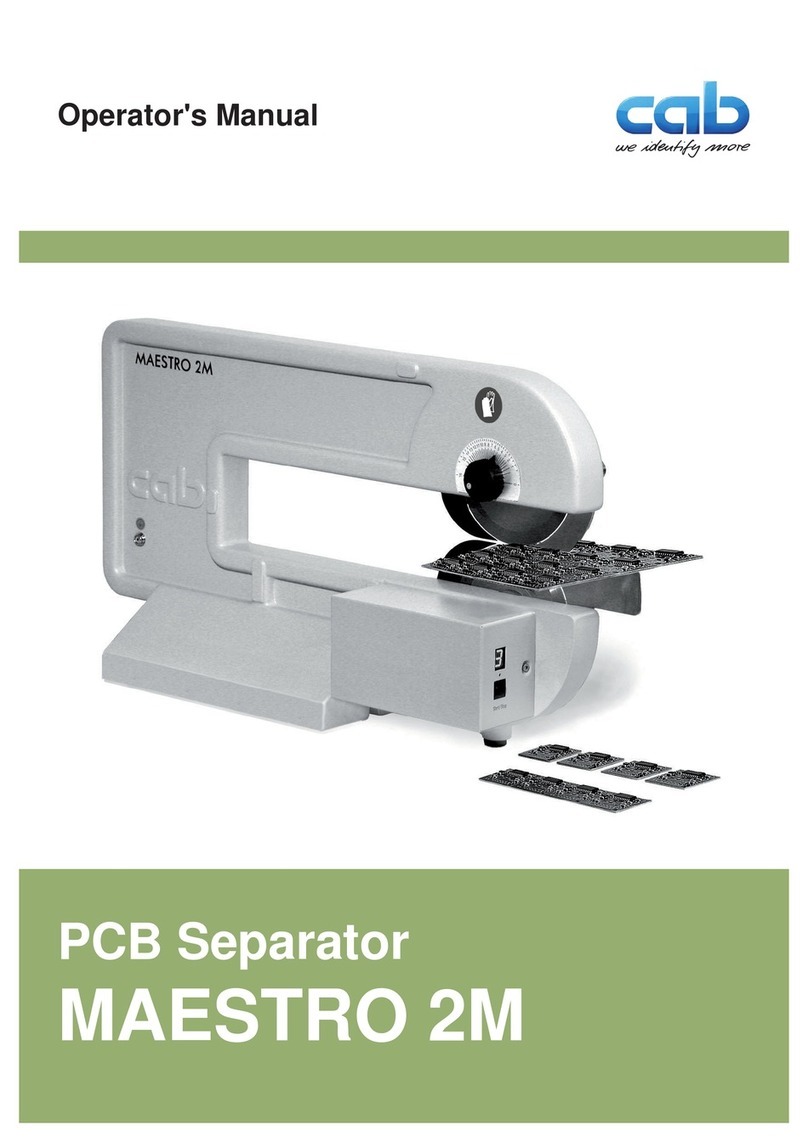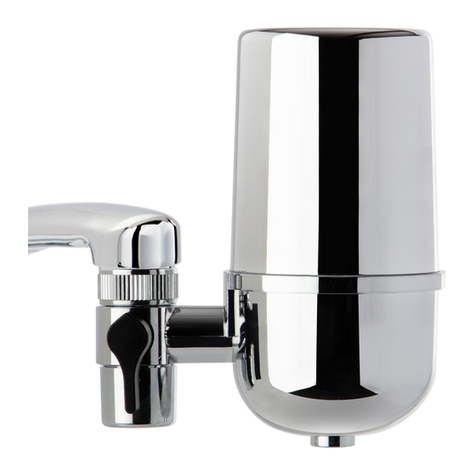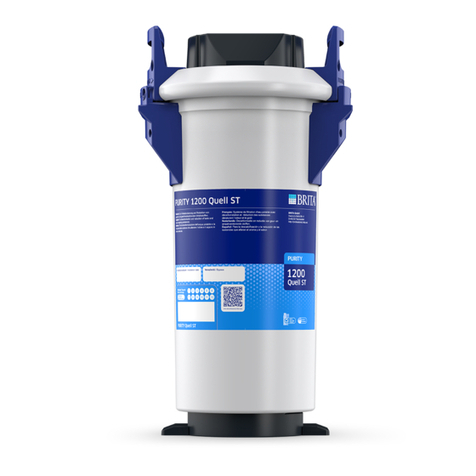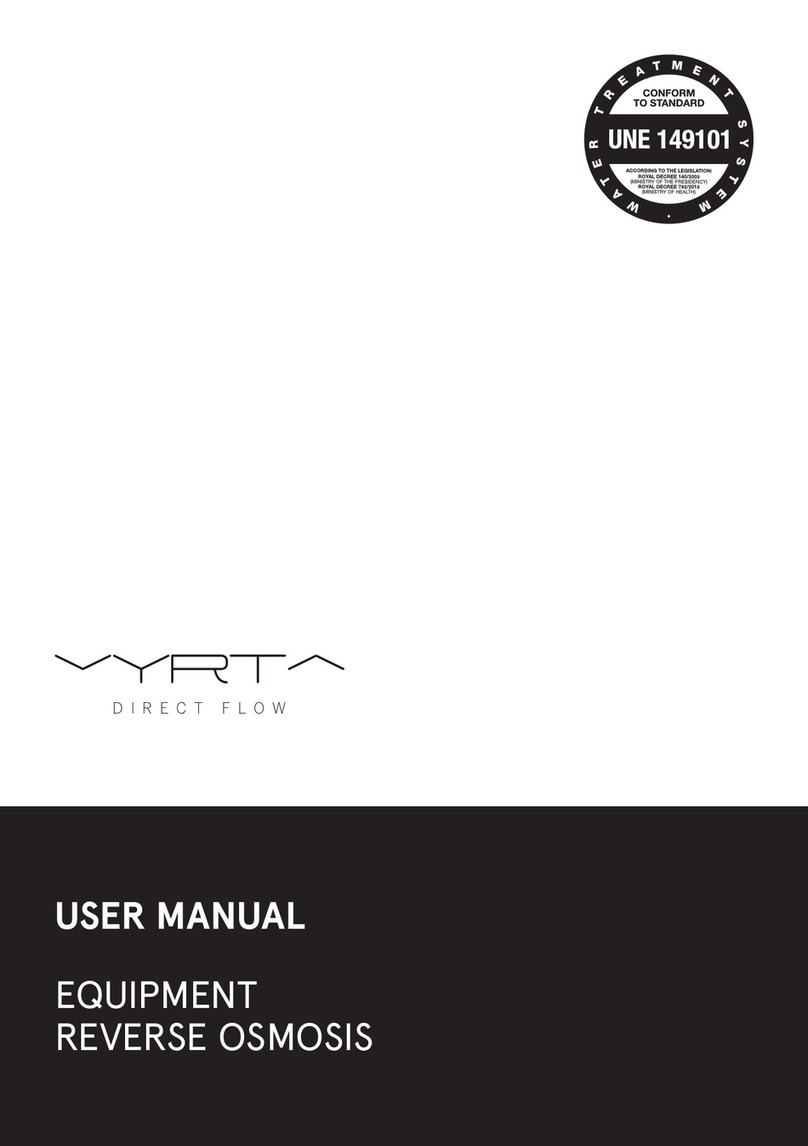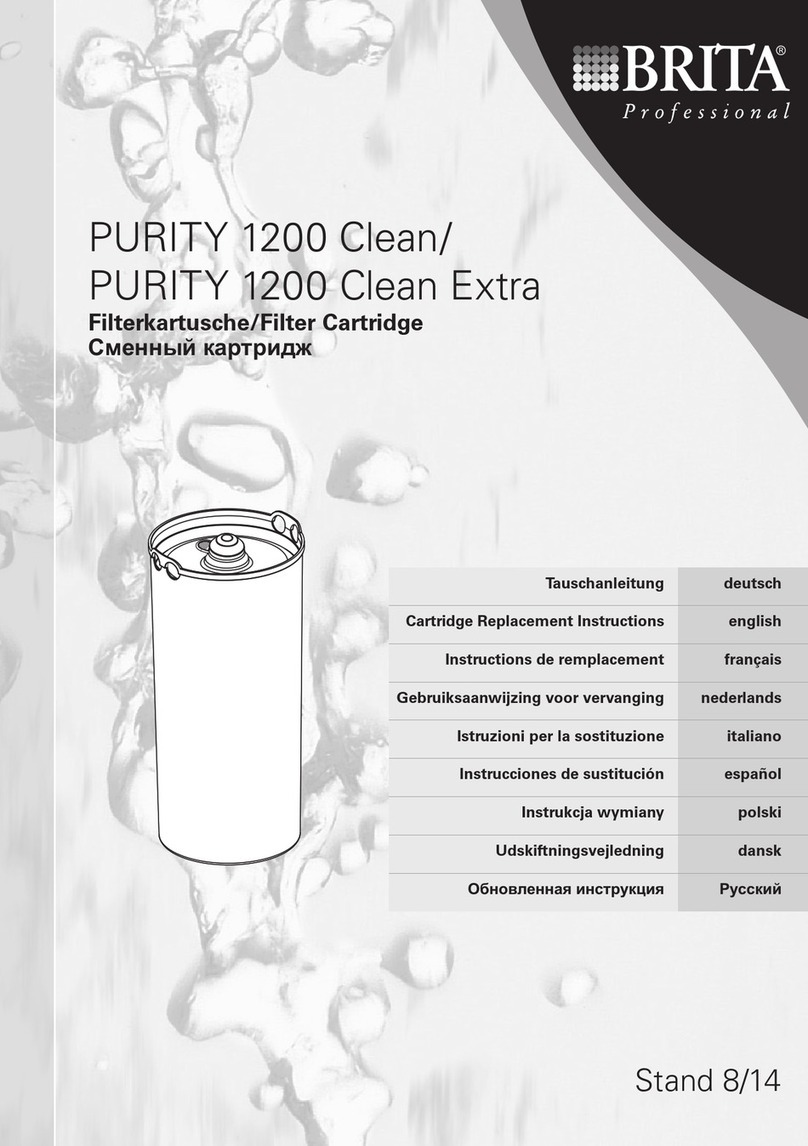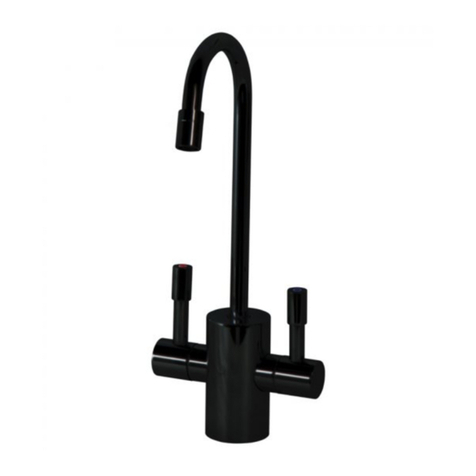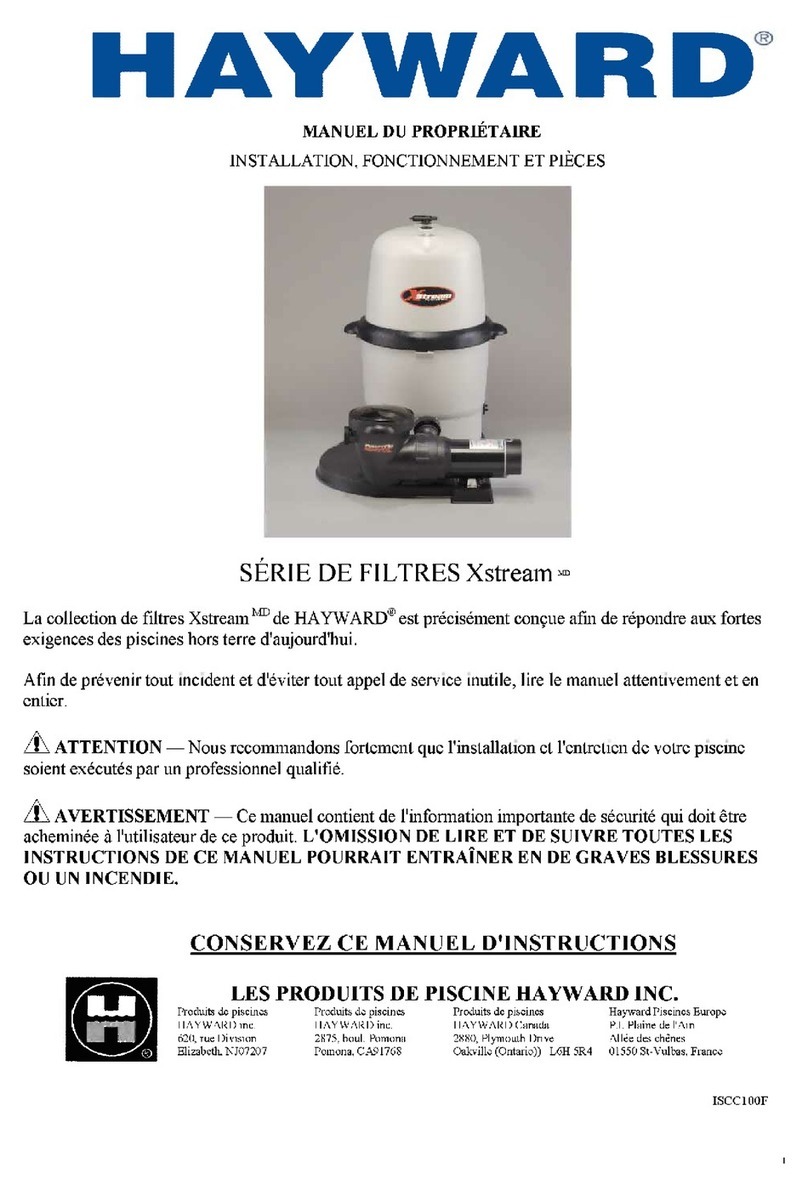Gigahertz Solutions FF10 User manual

FF10
FF10
Deutsch
Seite 2
Frequenzfilter
Zur Analyse verbreiteter Frequenzbänder
und Funkdienste
Bedienungsanleitung
English
Page 6
Frequency Filter
For the analysis of common frequency
bands and radio services
User Guide
Français
Page 11
Filtre de Fréquences
Pour l’analyse sélective des bandes de
hautes fréquences
Mode d’Emploi
DRU0207 - Rev. 2.3 – 1707

FF10
Danke!
Wir danken Ihnen für das Vertrauen, das Sie uns mit dem Kauf
dieses Gerätes bewiesen haben. Es erlaubt Ihnen eine qualifizier-
te Analyse entsprechend den Empfehlungen der Baubiologie.
Bitte lesen Sie diese Bedienungsanleitung unbedingt vor der
ersten Inbetriebnahme aufmerksam durch. Sie gibt wichtige
Hinweise für den Gebrauch, die Sicherheit und die Wartung des
Gerätes.
Thank you!
Thank you for purchasing our Frequency Filter. We appreciate
your confidence in our product. It allows you to perform a proper
analysis according to the recommendations of the Building Biol-
ogy Standard of Testing Methods.
Please read this user guide carefully prior to using this device. It
contains important information concerning the safety, use and
maintenance of this device.
Merci!
Nous vous remercions pour la confiance que vous nous avez
témoigné par votre achat de cet instrument. Il permet une
analyse conforme aux recommandations de la biologie de
l’habitat.
Veuillez lire impérativement et attentivement ce mode d’emploi
avant la première mise en service. Il comprend des informations
importantes concernant la sécurité, l’utilisation et l’entretien de
cet appareil.

FF10
© Gigahertz Solutions GmbH 1
WICHTIG / IMPORTANT
DE
Bitte maximal zwei Filter gleichzeitig auswählen, das
Gerät wird sonst nach einigen Minuten heiß und kann
Schaden nehmen. Mehr im Kapitel „Filterauswahl“.
EN
Please select a maximum of two filters simulta-
neously, otherwise the device will get hot after some
minutes and may take damage. More information in the
chapter „How to Select a Band Filt ich er“.
FR
SVP, faites attention de sélectionner un maximum de
deux filtres simultanément, sinon le filtre s’échauffera
après quelques minutes, et pourra subir des dom-
mages. Vous trouverez plus d’informations dans le
chapitre « Sélection de Filtres ».
Mit / With / Avec HFE35C, HF(E)5xx:
Kleine, werkseitige Schaltungsanpassung des Analy-
sers erforderlich (Für die Fernspeisung. Im Filterpreis
enthalten).
The analyser’s cirquitry needs minor factory adjustment
(For the remote power supply. Included in the price of
the filter).
Le circuit de l’analyseur nécessitera des petits ajuste-
ments en usine (Pour l’alimentation externe. Compris
dans le prix du filtre).

FF10
2© Gigahertz Solutions GmbH
.Deutsch.
Bedienelemente
Anschlussbuchse für das Antennen-kabel. Kabel
nicht knicken (Kabelführung siehe Seite 4) und Mutter
nicht überdrehen!
On/Off Ein-/Ausschalter (nur für Batteriebetrieb, ohne
Funktion bei Fernspeisung)
ok Leuchtet grün bei ausreichender Stromver-
sorgung.
Das Gerät verfügt im Batteriebetrieb über eine Auto-Power-Off-Funktion. Um
es nach dem Abschalten wieder in Betrieb zu nehmen bitte aus- und wieder
einschalten. Bei Anschluss an den HF Analyser, z.B. für Langzeitaufzeichnun-
gen, ist die Auto-power-Off-Funktion des Filters deaktiviert.
Stromversorgung
Mit einem HF58B, HF58B-r oder HF59B wird die zusätzliche
Batterie des Filters nicht benötigt – der FF10 wird durch den HF-
Analyser mit Strom versorgt. In diesem Fall braucht das Batte-
riegehäuse also nicht montiert zu werden.
Beim HFE35C unterstützt die Filterbatterie diejenige des Mess-
geräts. Beim HF32D, HF35C und HF38B erfolgt die Stromver-
sorgung des Filters ausschließlich über die Batterie im externen
Batteriegehäuse des Filters.
Wenn die „ok“-LED nicht mehr leuchtet, ist eine zuverlässige
Messung nicht mehr garantiert. Wenn auch die Filter-LEDs aus-
gehen, hat die Auto Power Off-Funktion das Gerät abgeschaltet.
Die Auto Power Off-Funktion ist deaktiviert, solange der Filter
vom HF-Analyser mit Strom versorgt wird, z.B. für Langzeitauf-
zeichnungen.
Nur HF35C, HF38B und HFE35C:
Batteriegehäuse montieren
Das externe Batteriegehäuse ist auf der Rückseite mit einer Haft-
folie versehen. Zunächst Schutzfolie abziehen und das Silikon-
schläuchlein zum Schutz der Batteriekontakte entfernen. Vor der
Kontaktierung auf jeden Fall die
Batterie aus dem Gehäuse ent-
fernen!
Dann können Sie das Batteriege-
häuse bei Bedarf auf der Rücksei-
te des Filters befestigen, wobei
sorgfältig auf die richtige Kontak-
tierung der Batteriekontakte
rechts unten am Batteriegehäuse

FF10
© Gigahertz Solutions GmbH 3
zu achten ist. Feinfühlig „einfädeln“, damit die Kontakte nicht
zwischen die Buchsen und das Gehäuse rutschen.
Eine glatte Unterlage hilft bei der
Ausrichtung.
Die Haftfolie ist ein hochwertiges
Klischeeband, ausgelegt auf
mehrfaches Anhaften und Ablö-
sen.
Zum Öffnen des Batteriegehäu-
ses recht kräftig von oben auf den
Deckel drücken und aufklappen.
Montage
Im Lieferumfang befindet sich das Material für zwei alternative
Befestigungsmöglichkeiten des Filters direkt auf dem Messgerät,
sodass die Messung eigenhändig durchgeführt werden kann.
1. Befestigung mit Latexband
Zur praktischen Einhandbedienung den Filter aufs Messgerät
legen, wie auf der Titelseite abgebildet (der „On“-Schalter nach
rechts).
Antenne und Messgerät anschließen. Bei Ver-
wendung des Holsters reichen meist zwei Fin-
ger am Antennenkabel zur Fixierung des Filters
(siehe Bild).
Nötigenfalls kann der Filter mit einem dauerhaft
elastischen, synthetischen Latexband weiter
fixiert werden, welches von der linken zur rech-
ten SMA Buchse unter dem Messgerät hin-
durch geführt wird:
Anschließend wird die Antenne links, das Messgerät rechts an-
geschlossen. Die Kabel dabei passend biegen, jedoch keinesfalls
knicken!

FF10
4© Gigahertz Solutions GmbH
2. Befestigung mit „Pilzband"
Die Klebeflächen fettfrei machen, um eine optimale Haftung zu
gewährleisten (beispielsweise mit Spiritus oder Alkohol).
Untere Schutzfolie des Pilz-
band-Bündels abziehen und
das Bündel zwischen Typenbe-
zeichnung und VBW-Schalter
auf den Analyser kleben und
fest anpressen.
Obere Schutzfolie abziehen und
FF10 mittig auf das Pilzband-
Bündel aufkleben und ebenfalls
fest anpressen. Antennenkabel
an der linken Buchse anschlie-
ßen und die rechte Buchse mit
dem Analyser verbinden.
Hinweis zur Demontage der Pilzband-Befestigung:
Der Zusammenhalt des Pilzbandes ist erstaunlich fest. Bei der
Demontage besteht deshalb die Gefahr, dass sich anstelle der
Pilzband-Verbindung die Verklebung des Pilzbandes am Filter
bzw. am Messgerät löst.
Um das zu vermeiden sollten das Messgerät und der Filter nicht
direkt auseinander gezogen werden, sondern der Filter langsam
in Richtung Stirnseite des Messgeräts umgeklappt werden, um
das Pilzband möglichst Stück für Stück voneinander zu lösen.
Zwecks einfacherer Demontage ist der Streifen relativ klein.
3. Optional erhältlich: „Zweihand-Lösung“
mit Verbindungskabel
Bei dieser Lösung wird die UBB27 fest mit dem FF10 verbunden
und diese Filter/Antennen-Kombination über ein 1m-Koaxkabel
mit dem Messgerät angeschlossen. Die Kosten für das Umbau-
Kit inklusive Montage im Werk finden Sie auf unserer Homepage.
Funktion
Der Filter lässt nur das gewählte Frequenzband passieren und
unterdrückt alle anderen Frequenzen.
Alle Filter inkl. „LP 480 MHz“ und „broadband“ (Position, in wel-
che der volle Frequenzgang der Antenne durchgelassen wird),
sind kompensiert, d.h. die Durchgangsdämpfung wird durch fre-
quenzabhängige Verstärkung ausgeglichen.

FF10
© Gigahertz Solutions GmbH 5
Einstellbare Filter
Bezeichnung Umfasste Bänder / Dienste
broadband 27 MHz bis > 3300 MHz (ggf. begrenzt durch
den HF-Analyser)
LP 480 MHz u.a. TETRA, DAB, CB-Funk, ISM, Radio
TETRA TETRA-BOS
800 MHz LTE/4G
900MHz GSM (vereinzelt auch UMTS/3G)
1800 MHz GSM, LTE/4G
DECT DECT
2100 MHz UMTS/3G
WLAN WLAN 2,4 GHz
2600 MHz LTE/4G
Filterauswahl
Die Auswahl der Filter erfolgt über Berührung der Touch-Schalter
auf der Oberseite des Geräts.
Die Stromversorgung durch den HF-Analyser ist darauf ausge-
legt, nur einen Filter zur Zeit mit Strom zu versorgen. Mit externer
Stromversorgung können kurzzeitig auch mehr Filter mit Strom
versorgt werden (Vorsicht: das Gerät wird in diesem Fall heiß).
Auch bei Benutzung einzelner Filter kann das Gerät nach einigen
Minuten handwarm werden. Das ist unbedenklich.
Es ist unsinnig, die Filter „broadband“ und „LP 480 MHz“ gleich-
zeitig oder zusammen mit einem anderen Filter zu benutzen.
Anwendung
Um die Gesamtbelastung im Raum innerhalb eines Filterbandes
zu ermitteln, wählen Sie den entsprechenden Filter und gehen
gemäß der Anleitung Ihres HF-Messgerätes vor.
Zum Vermessen der Emission einer einzelnen HF-Quelle soll-
ten Sie die Logper-Antenne verwenden, mit „Peak-hold“ und
unter leichtem Schwenken bzw. Positionsveränderung zumindest
einige Sekunden in Richtung dieser Quelle messen um einen
belastbaren Wert zu erhalten. Bei Signalen mit hohem Crestfak-
tor ist eine deutlich längere Messung sinnvoll.
Genauigkeit
Typische Unterdrückung unerwünschter Frequenzen: mindes-
tens 40-60 dB. Sonderfall GSM/LTE1800: Die Separation gegen-
über DECT beträgt mindestens 20-30 dB.
Keine Dämpfung im Durchlassbereich!
Maximaler zusätzl. Messfehler: 0 bis +3 dB.
Messgerätespezifische Korrekturfaktoren für bestimmte Signale
(z.B. UMTS oder LTE) sind auch mit Filter anzuwenden.

FF10
6© Gigahertz Solutions GmbH
.English.
Control Elements
Input jack for antenna cable. Do not sharply bend
antenna cable (see page 9 for best arrangement) or
overtighten connector.
On/Off Switch (for battery operation only, without function
when powered by the analyser)
ok Power LED: lights up green in the case of sufficient
power supply
For battery operation, the device has an auto power off func-
tion. To re-activate the meter after an automatic shutdown,
simply turn the device off and back on. While connected to the
HF-Analyser, e.g. for performing long-term data logging, the auto
power off function will be automatically disabled.
Power Supply
With the HF58B, HF58B-r or HF59B, no additional battery is
needed – the FF10 will be powered by the HF-Analyser. In this
case, the battery housing does not need to be mounted.
With the HFE35C, the filter battery supports the meter battery.
With the HF32D, HF35C, and HF38B, the filter is exclusively
powered by the extra battery in the external battery housing.
A standard 9V alkaline-manganese or lithium battery placed in an
external battery box can directly supply the FF10 with power,
this way saving capacity of the meter battery.
Once the “ok“ LED has gone off, a valid measurement can no
longer be guaranteed. If the filter LEDs also go off, the meter has
been automatically switched off by the auto power off function.
The auto power off function is automatically disabled if the filter
is powered by the HF-Analyser, for instance in the case of long-
term recordings.

FF10
© Gigahertz Solutions GmbH 7
HF35C, HF38B, and HFE35C only:
How to Mount the Battery Housing
The external battery box is furnished with an adhesive foil on its
back. Please remove the protective foil as well as the little sili-
cone loop for the protection of the battery contacts. Before ad-
hering the battery container make sure to remove the bat-
tery!
Then you can adhere the box onto
the back side of the filter. Please
make sure the battery contacts
at the bottom right of the battery
box are correctly connected.
Carefully “thread” the contacts
in order to make sure they don’t
slip in between the housing and
the receptacle.
An even surface helps aligning the
arrangement.
The adhesive foil is made of a
high quality cliché band designed
for multiple use.
In order to open the battery box,
please press firmly from above,
and open the lid.

FF10
8© Gigahertz Solutions GmbH
How to Mount the Frequency Filter
The scope of supply includes two alternative solutions to mount
the filter directly on top of the meter, allowing a single-hand
measurement.
4. Mounting with an elastic band
For a convenient one-hand-use, place the filter onto the meter as
shown on the front page ( “On”-switch facing to the right).
Connect antenna and analyser. When using the
meter with holster, the filter can easily be stabi-
lized with two fingers on the antenna cable (see
picture).
If need be, the filter can additionally be stabi-
lized with the help of a permanently elastic syn-
thetic latex band attached to the SMA sockets
on the left and right sides of the filter and
passed through underneath the instrument:
Then please connect the antenna onto the left socket and the
meter onto the right socket of the filter. Carefully bend the an-
tenna cable into the needed position, but take care not to kink it.
5. Mounting with a Velcro strap
Clear the adhesive surface from grease to ensure optimal ad-
hesion (e.g. with spirit or alcohol).
Remove the bottom protective
foil from the Velcro block, and
adhere Velcro block onto the
top surface of the analyser be-
tween the meter name and the
VBW switch. Press tightly.
Remove the top protective foil
of the Velcro block, and place
the filter centrally onto it. Again
press tightly. Attach antenna
cable to the left SMA socket,
and the meter to the right SMA
socket of the filter.

FF10
© Gigahertz Solutions GmbH 9
Hints for a safe disassembly of the Velcro mounting:
The Velcro supplied with the filter has an astonishingly good ad-
hesive strength. You may therefore run the risk of loosening the
adhesion of the Velcro from the meter or filter instead of discon-
necting the two Velcro pieces when trying to dismount the filter.
To avoid this, please do not pull apart the filter and the meter,
but carefully fold the filter towards the front of the meter so as to
loosen the Velcro pieces bit by bit. For an easier disassembly,
we have minimized the sizes of the Velcro pieces.
6. Optionally available: “Two-hand solution”
with connecting cable
For this solution, the UBB antenna needs to be tightly connected
to the FF10, and this filter/antenna combination then attached to
the meter with a 1m coaxial cable. The fees for this modification
kit and the corresponding assembly in our factory can be found
on our homepage.
How the Filter Works
The filter only allows the selected frequency band to pass
through, and suppresses all other frequencies.
For all filter settings – including “LP 480 MHz” and “broadband”
(which is the bypass position at which all frequencies of the an-
tenna pass) – the frequency response is compensated, that is,
the occurring insertion loss is compensated by a frequency-
specific amplification.
Selectable Filters
Labeling Included Bands / Services
broadband 27 MHz to > 3300 MHz
(limited by the HF-Analyser in use)
LP 480 MHz amongst others: TETRA, DAB, CB Radio,
ISM 433 MHz, radio
TETRA TETRA-BOS
800 MHz LTE/4G
900MHz GSM (sporadical UMTS/3G)
1800 MHz GSM, LTE/4G
DECT DECT
UMTS UMTS/3G
WLAN WLAN 2.4 GHz
2600 MHz LTE/4G

FF10
10 © Gigahertz Solutions GmbH
How to Select a Band Filter
Specific filters can be selected by tapping the touch switch at
the front panel of the Frequency Filter.
The power supply through the HF-Analyser is designed to feed
one filter at the time. For short periods of time the external power
supply can feed more filters (caution: this may cause the filter to
get hot). Even when using single filters the device may get luke-
warm, which is harmless.
Please note that technically it makes no sense to use the
“broadband” and “LP 480 MHz” filter simultaneously or together
with any other filter.
How to Measure with the Filter
To assess the total exposure in a given space within a specific
band of the Frequency Filter, tap the touch switch of the desired
frequency band and follow the general instructions in the user
guide of your HF-Analyser.
To measure the emission of a single RF source, preferably use
a logarithmic-periodic directional antenna and select “Peak
Hold,” while slightly panning the antenna toward the general di-
rection of the RF source for at least several seconds to capture a
reasonable test result. In the case of RF signals with a high crest
factor, we recommend using a considerably longer measurement
period.
Measurement Accuracy
Typical suppression of unwanted frequencies: min. 40-60 dB.
Exception: GSM/LTE1800 – Here the selectivity vs. DECT is bet-
ter than 20-30 dB.
No insertion loss in the pass band!
Max. additional measurement error: 0 to +3 dB.
The correction factors specified for the respective meters also
apply to the filter for certain signals (e.g. UMTS or LTE).

FF10
© Gigahertz Solutions GmbH 11
.Français.
Elements de Réglage
Prise de raccordement pour l‘antenne. Faites atten-
tion de ne pas plier le câble (voir page 14) et de ne
pas forcer l’écrou!
On/Off Marche/Arrêt (uniquement pour l’utilisa-tion avec
piles, hors function en cas de l’alimention en courant
par l’HF-Analyser)
ok LED s’allume en vert en cas d’alimentation
électrique suffisante.
Pour l’utilisation du filtre avec piles, l’appareil a une fonction de
mise hors tension automatique Auto-Power-Off. Pour remettre
en service l’appareil après la mise hors tension automatique, il
faut l’éteindre et le rallumer. Si le filtre est raccordé à un
analyseur HF, par ex. pour des enregistrements de longue durée,
la fonction Auto-Power-Off est automatiquement déactivée.
Alimentation en Courant
Avec le HF58B, HF58B-r ou HF59B on n’a pas besoin d’une
batterie additionnelle – le filtre est alimenté en courant par
l’analyseur HF. Dans ce cas, il n’est pas nécessaire de monter
le boîtier de batteries.
Avec le HFE35C, la batterie du filtre supporte aussi la batterie de
l’analyseur. Avec le HF32D, HF35C, et HF38B, le filtre est
alimenté exclusivement par la batterie dans le boîtier externe.
Une fois la LED verte „ok“ éteinte, une mesure fiable ne peut
plus être garantie. Si les LEDs du filtre s’éteignent aussi, cela
signifie que la fonction Auto Power Off a mise hors tension
l’appareil.
La fonction Auto Power Off est auto-matiquement déactivée
tant que le filtre est alimenté en courant par l’analyseur HF, par
ex. pour des enregistrements à long terme.

FF10
12 © Gigahertz Solutions GmbH
Pour HF35C, HF38B, et HFE35C:
Montage du Boîtier de Batteries
Le boîtier externe de batteries est revêtu d‘une feuille adhésive à
l’arrière. Veuillez d’abord retirer la feuille de protection et enlever
la petite tubulure en silicone qui protège les contacts de la
batterie. De toute façon enlevez la batterie du boîtier avant de
le mettre en contact.
Vous pouvez alors coller le boîtier
directement sur l’arrière du filtre.
Veillez bien à ce que le contacte
des batteries en bas à droite du
boîtier de batteries soit correcte.
“Enfiler” de manière sensible
pour éviter que les contacts
glissent entre les prises femelles
et le boîtier.
Une surface lisse vous aidera
avec l’alignement.
La feuille adhésive est une bande
cliché de grande qualité apte pour
une utilisation multiple.
Pour ouvrir le boîtier de
batteries, veuillez appuyer
fortement par le haut sur le
couvercle.

FF10
© Gigahertz Solutions GmbH 13
Montage du Filtre
La livraison comprend le matériel pour deux possibilités alterna-
tives d‘assemblage du filtre directement sur l’instrument de sorte
que l’utilisateur peut faire des mesures à une seule main.
7. Assemblage avec une bande élastique
Pour une utilisation facile à une seule main veuillez monter le
filtre sur l’analyseur comme illustré sur la première page
(l’interrupteur « On » doit être orienté vers la droite).
Ensuite, veuillez attacher l’antenne à
l’instrument. Si vous utilisez un holster, le filtre
peut facilement être stabilisé avec deux doigts
sur le câble de l’antenne (voir image).
Si nécessaire, le filtre peut en plus être fixé
avec l’aide d’une bande en latex synthétique
d’élasticité durable raccordé avec les jacks
SMA sur la gauche et la droite du filtre et passé
par le bas de l’instrument:
Ensuite, il faut attacher l’antenne à la gauche et l’instrument à la
droite. Adaptez le câble en le courbant avec précaution. Ne pas plier!
8. Assemblage avec une bande Velcro
Assurez-vous que les surfaces à coller soient dégraissées afin
d’obtenir une adhérence optimale (par ex. avec alcool dénaturé).
Retirez le film de protection de
la partie inférieure du Velcro et
placez le bloc de Velcro entre le
nom de l’appareil et
l’interrupteur du VBW. Pressez
fermement.
Retirez le film de protection de
la partie supérieure du Velcro et
placez le filtre FF10 centré.
Pressez encore une fois ferme-
ment. Attachez le câble de
l’antenne au jack SMA á la
gauche, et l’analyseur au jack
SMA à la droite.

FF10
14 © Gigahertz Solutions GmbH
Remarque regardant le démontage de la fixation Velcro :
Le Velcro fourni avec le filtre est d’une cohésion très forte. Lors
du démontage il y a donc le risque de détacher le collage du
Velcro de l’instrument ou du filtre envers de la connexion entre
les pièces du Velcro.
Pour éviter cela ne pas tirer l’analyseur du filtre, mais incliner le
filtre en avant vers l’analyseur afin de lentement détacher une
pièce du Velcro de l’autre. Pour rendre plus facile le démontage,
les pièces de Velcro sont relativement petites.
9. Disponible en option: Solution bi-manuelle avec câble de
connexion
Pour cette solution, l’antenne UBB27 doit être fermement con-
nectée avec le filtre FF10, et cette combinaison du filtre et de
l’antenne doit être raccordée avec l’instrument en utilisant un
câble coaxial d’un mètre. Les goûts pour ce kit de modification
et son assemblage en usine se trouvent sur notre site web.
Fonctionnement
Le principe de fonctionnement du filtre est de permettre le
passage de la bande de fréquences sélectionnée et la
suppression de toutes les autres fréquences.
Tous les filtres, y compris le „LP 480 MHz“ et „broadband“ (soit
la position „Bypass” qui permet de faire passer l’entièreté de la
réponse en fréquences de l’antenne), sont compensés, c’est-à-
dire l’atténuation est compensée par une amplification
dépendante de la fréquence.

FF10
© Gigahertz Solutions GmbH 15
Filtres sélectionnables
Désignation Bandes comprises / Services
broadband 27 MHz à > 3300 MHz
(eventuellement limité par l’analyseur HF
correspondant))
LP 480 MHz Par ex. TETRA, DAB, radio CB, ISM 433
MHz, radio
TETRA TETRA-BOS
800 MHz LTE/4G
900MHz GSM (sporadiquement aussi UMTS/3G)
1800 MHz GSM, LTE/4G
DECT DECT
2100 MHz UMTS/3G
WLAN WLAN 2,4 GHz
2600 MHz LTE/4G
Sélection de Filtres
Les filtres peuvent être sélectionnés en touchant l‘interrupteur
tactile situé sur le dessus de l’appareil.
L’alimentation en courant fournie par l’analyseur HF vise à fournir
du courant à un seul filtre à la fois. Une source externe de
courant peut alimenter plusieurs filtres à la fois pour une durée
limitée (Attention: Dans ce cas l‘appareil peut chauffer forte-
ment). Même en cas d’utilisation d’un seul filtre, l’appareil peut
devenir tiède, mais c’est normal et sans risque.
Avis: Techniquement, il n’est pas judicieux d’utiliser le filtre
„broadband“ en même temps que „LP 480 MHz“ ou avec
n’importe quel autre filtre.
Emploi
Pour évaluer l’exposition globale dans une pièce et dans une
des gammes de fréquences du filtre, sélectionnez la position
souhaitée du filtre et procédez selon les instructions générales
de votre appareil de mesure HF.
Pour déterminer l’émission d’une seule source HF, il faut utili-
ser l’antenne directionnelle log-per et de préférence mesurer avec
la fonction « Peak-Hold » en orientant l’appareil un peu pendant
quelques secondes vers la source en question, afin d’obtenir une
valeur fiable. En cas de signaux avec un facteur de crête élevé, il
est utile de prolonger notablement la durée de la mesure.

FF10
16 © Gigahertz Solutions GmbH
Précision
Suppression typique de fréquences non désirées: > 40-60 dB.
Exception GSM/LTE1800: La séparation vis à vis du DECT est
d’au moins 20-30 dB.
Il n’y a aucune atténuation de passage!
Erreur de mesure supplémentaire maximale: 0 à +3 dB.
Les facteurs de correction spécifiques de l‘analyseur respectif
pour certains signaux (par ex. UMTS ou LTE) sont aussi valables
pour les mesures avec le filtre.

FF10
© Gigahertz Solutions GmbH
Garantie
Auf diesen Filter gewähren wir zwei Jahre Garantie auf Funktions-
und Verarbeitungsmängel.
Warranty
We provide a two year warranty on factory defects of this filter.
Garantie
Pour ce filtre il y a une garantie de deux ans contre tous les
défauts de fonctionnement et de fabrication.

FF10
© Gigahertz Solutions GmbH
Hersteller / Manufacturer / Fabricant:
Gigahertz Solutions GmbH
Am Galgenberg 12
90579 Langenzenn
Germany
Phone +49 (0)9101 9093-0, Fax -23
www.gigahertz-solutions.de / .com / .fr
Other manuals for FF10
1
Table of contents
Languages:
Other Gigahertz Solutions Water Filtration System manuals
Popular Water Filtration System manuals by other brands
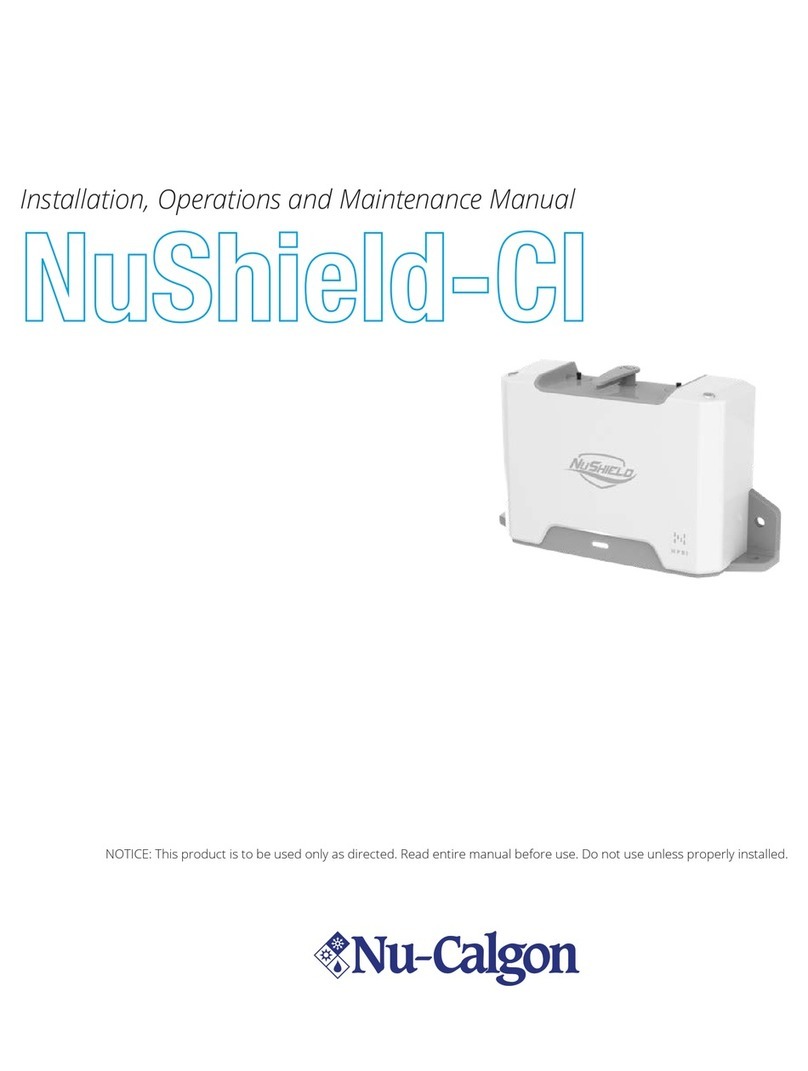
Nu-Calgon
Nu-Calgon NuShield-CI Installation, operation and maintenance manual
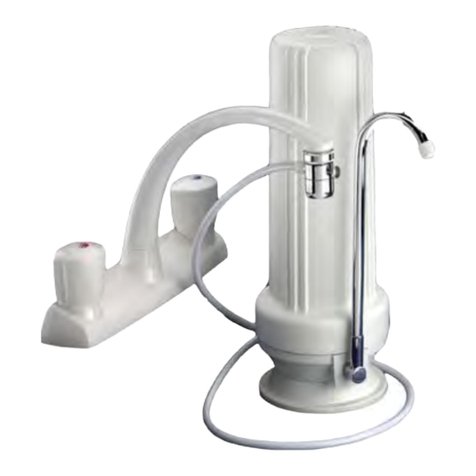
Watts Premier
Watts Premier CT-1 Installation, operation and maintenance manual

Wyckomar
Wyckomar UV-1 Installation and maintenance manual

SunSun
SunSun CBG-500 Operation manual

Pentair
Pentair FLECK 4600 SXT Installer manual

Applied Membranes
Applied Membranes W-G844EM Operation and maintenance manual
